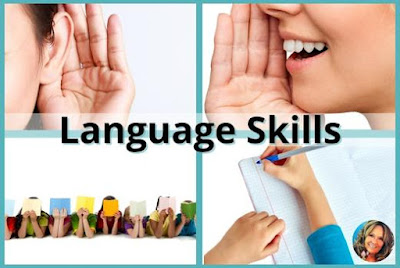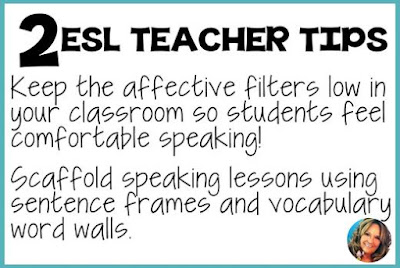Are you ready to put teaching on overdrive for your English Language Learners?

But keep on reading because this post with all of its ESL teacher tips will get you to the top of your game as the school year happens. This post, the first in a three-part series, focuses on listening and speaking skills and the next two will explore reading and then writing and grammar.
Since you’re ready to learn, let’s get started!
If you’re reading this, I’m here to tell you that you probably already are!
What are language skills?
The four basic language skills are listening, speaking, reading, and writing. Many teachers include grammar as a fifth language skill. I agree! Educational achievement for ELLs requires proficiency in all 5 of these skills. If you teach ELLs then these basic language skills should be at the very heart of your instruction. Using activities and games in your daily lessons that incorporate some or all of the 5 communication skills builds fluency and language competency. This is the key to academic success.

How do we teach these skills to English Language Learners? That is the big question. Let’s take a look at each individual skill, starting with listening and speaking
Teaching English Language Learners: Listening Skills
Building listening skills requires amazing ESL teachers to regularly teach and practice this skill with their students.
Listening skills are the semantic aspect of a language and start with the ability to distinguish sounds, words and sentences. Discriminating sounds are the foundation to reading and writing. ELLs need to learn more than just the sounds of English. The complexities of good listening need to be taught in order to extract meaning, analyze what they have heard and be able to reply, discuss, or argue the information given.
ELLs need to be able to gain meaning from listening. They need to learn the protocol of being a good listener. ELLs need to develop the ability of careful listening and the capacity to maintain that listening in a second (or 3rd) language.
Teaching listening skills can be FUN! And you can be amazing without worrying about planning all of the lessons all of the time! Check out these bundles whether you have newcomers, intermediate, or advanced ELLs!

Teaching listening skills can be FUN! Here are 5 ideas for teaching English Language Learners in your class:
- Play board games that focus on reading and listening. One student reads a word, short phrase, or sentence depending on language level. The player must repeat exactly what was said. If the response is correct, the player rolls the dice and moves her/his game piece. With more advanced language students use a paragraph or short article and have the player paraphrase the article.
- Play music and have students raise their hand or stand up each time they hear a predetermined word in a song.
- Play listen and do games.
- Dictation where students write down exactly what the teacher says. This is harder than you think!
- Information transfer is a great listening skills activity. Present information orally. Students represent what they heard by making a drawing/picture, chart, or table. You can use this activity in reverse to develop oral skills!
Teaching English Language Learners: Speaking Skills
Oral/Speaking skills require amazing ESL teachers to teach and practice specific lessons and activities with their students.
Speaking skills are the phonetic aspect of a language and include what conversation looks and sounds like, including what each person will do.
Although vocabulary and grammar are the foundation of speaking, ELLs need to learn the behavioral differences of conversations, debate, informal and formal language. Students need instruction on how to verbally ask questions, explanations, make requests, express their feelings, and disagree. The intricacies between these communications not only include grammatical forms but extends to intonation, stress, pitch, and pronunciation. Teaching English Language Learners when and how to use or not use idioms and figurative language is also imperative to include in oral and written lessons.

ELLs should be instructed on how to conduct themselves in formal and informal situations including when and where to use casual speech patterns such as; you know, so, I mean, right and kind of. Semantics is more than the literal meanings of words. Semantics reveals the culture and community by revealing subtle connotations in a unique manner. I always teach my oral language lessons by language function. We talk about where we would use this type of language and what the situation might be.
Teaching speaking skills can be FUN! Here are 8 of my favorite activities for developing oral language:
- Games that promote oral language
- Storytelling
- Reader’s theater
- Role Play
- Students love to use computers. Have them video themselves giving a short introduction, giving directions, talking about what they did the night before or will do tomorrow.
- Who is it? Great for teaching how to ask questions. Students write facts about themselves and turns it into the teacher. The teacher reads random facts and the students question each other to determine who wrote the fact.
- I have never…
- Describing pictures of objects or events. Great for compare and contrast language if you have 2 pictures that are similar!

Two ESL teacher tips to ensure success are to make sure to keep the affective filters low in your classroom so students feel comfortable speaking and to scaffold your speaking lessons using sentence frames and vocabulary word walls.
And the best ESL teacher tip of all is to check out this mega bundle of activities that focuses on all four language skills!
Congratulations you are on your way to becoming an amazing ESL teacher this year. I hope you found an educational nugget or two that you can use this year teaching English Language Learners in your class!
Go Bold!
Be Great!
You are Amazing!
Your partner in ESL!
Lori,
Happy Teaching!


No comments:
Post a Comment